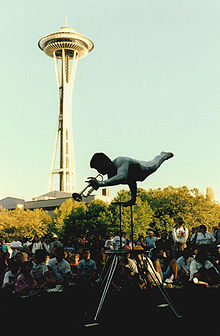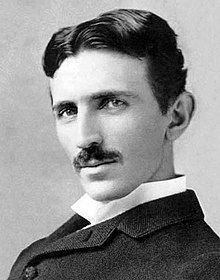Wikipedia:Why Johnny can't wiki-read
This is an essay. It contains the advice or opinions of one or more Wikipedia contributors. This page is not an encyclopedia article, nor is it one of Wikipedia's policies or guidelines, as it has not been thoroughly vetted by the community. Some essays represent widespread norms; others only represent minority viewpoints. |

This essay concerns issues of readability for Wikipedia articles. Many articles need to be revised to treat the lead section (also known as the introduction) as a balanced overview of the topic, and move excessive details to lower portions of the article. Long sentences can be split, or commas/hyphens can be added. Also, key concepts should be repeated to be noticed when scan-reading an article. This essay's title comes from the phrase "Why Johnny Can't Read", a common expression used in American education to focus improving the reading skills of school students.
Re-balancing the intro text
[edit]As articles age, and are modified, the top intro text tends to no longer represent the full scope of the article. Also, many people concentrate on packing extra details later in an article, or simply tacking whatever text, which they want emphasized, into the intro paragraphs. As a result, the intro must, occasionally, be rewritten, for balance, to reflect all the changes over the intervening months (or years) since the article was first created. Excessive details in the top section should be moved to lower portions of the article, to avoid WP:UNDUE details at the top.


For example, an overly-long description of the origin of the article's topic should be shortened, or perhaps moved to a separate section, rather than risk overwhelming or boring readers with too many background details in the top text. A complex pronunciation, with perhaps different accents by region, could be moved into a footnote. A possible technique for achieving balance is to briefly describe a topic, in terms of the 6 W's: who, what, when, where, why and how. Next, some information should be included about current impact, but limit the origins of the topic to a short amount of text, in the intro section. Try to use an action-oriented approach: word the intro so that a person could use the information in the most-likely manner, for that particular topic.
Beware that, typically, the intro section, of each article, could be the target of "spam text" which attempts to POV-push some idea or person, often only remotely related to the subject of the article. For example, in article "Thomas Edison", an editor might try to over-emphasize, in the top section, that "John Q. Public was the actual inventor of 3 techniques for which Edison bought the patents" (or such). Similar over-detailed text should be moved into lower sections of the article, which list the various notable people who invented techniques which Edison later used. However, a phrase could be added, into the lede, to generally note how many people contributed their inventions, or hard work, later attributed to the "Wizard of Menlo Park". Also, consider spam text which might be added into article "Nikola Tesla".
Re-balancing the article sets
[edit]Many articles on Wikipedia are focused on subjects which, overall, are out of balance with the world at large. The imbalance might be the result of systemic bias, caused by the structure and typical personalities of groups of people, rather than a conscious attempt to slant the content of Wikipedia. However, there is strong evidence to show how a sizeable portion of Wikipedia has been slanted.
The average ages of people covered, in the thousands of Wikipedia biography pages, tends to mirror the age of the editors. Most editors are generally 26-27 years old, and most Wikipedia biography articles are about people who are around 26-27 years old. Compare the article counts in the various birth/age categories:
- Category:1970 births (16,729), Category:1973 births (15,669), Category:1974 births (15,824)
- Category:1980 births (16,803), Category:1983 births (17,375), Category:1984 births (17,706)
- Category:1990 births (18,255), Category:1993 births (17,122), Category:1994 births (16,883)
Consequently, Wikipedia editors should focus more on people born earlier than 1983-1984 to re-balance the coverage of biography articles to older people.
Shortening and clarifying sentences
[edit]Another major issue (often critically important), to improve the readability of articles, is to simply split long sentences and try to clarify any obscure wording. In technical articles, it is often difficult to reword a sentence without, inadvertently, changing the meaning, so simply inserting extra commas and hyphens (in multi-word adjectives) can help clarify phrases. A common use for extra commas is to surround "parenthetical expressions" where a descriptive phrase can be separated, as a unit, from the rest of a sentence. For example, consider the classic garden path sentence:
- From: "Cotton clothes are made of grows in Mississippi."
- To: "Cotton, which clothes are made of, grows in Mississippi."
- To: "Cotton, from which clothes are made, grows in Mississippi."
Relative pronouns can help clarify relative clauses:
- From: "The cotton clothes are made of grows in Mississippi."
- To: "The cotton that clothes are made of grows in Mississippi."
| Some consider cheetahs to be almost identical twins, because their DNA contains so much repetition. |
Beware how some cultures, which use variations of the English language, try to remove excessive commas, as considered to be "comma splices" interrupting the word-flow. In those cases, other editors might come to an article to remove "15" commas which they considered to be excessive punctuation. From their viewpoint, the extra commas should be removed because they were thought to be distracting to readers (from their culture).
Hence, there can be editor disputes about using commas to separate complex phrases; so, in those cases, it might be acceptable to replace commas with sets of parentheses "( )" around some phrases (to avoid edit-wars about the commas) as acceptable punctuation. Otherwise, just split a sentence, when too many phrases are jumbled together.
For example, a technical phrase, seeming too long, could use "( )" and commas:
- From: "In 2010 Windows Vista graphics dynamic link libraries for speed used widgets."
- To: "In 2010, Windows Vista graphics, the dynamic link libraries (for speed) used widgets."
Similar situations arise where hyphens could be used to join multi-word phrases (such as "dynamic-link libraries") to allow hyphens to show the groupings of related words.
Repeating key concepts in non-boring ways
[edit]
Another technique, to improve the ability for readers to better understand an article, is to repeat some major ideas, in non-boring ways. The plan is to use repetition, of key concepts, to ensure how scan-readers would be less-likely to glance though an article, too fast, and overlook the major issues.
One option, to use repetition, is to repeat a key concept in an image-caption, where the text in the image-box will summarize a major concept (again), while having wikilinks to key terms being mentioned (again).
In general, excessive redundancy should be avoided; otherwise, if everything were repeated, then an article obviously would become twice as large. Hence, the key concept is to repeat the key concepts, not all minor details. Per the humorous quip, remember: "Some redundancy is good redundancy".
See also
[edit]- WP:98 percent table width anomaly
- WP:About translating German Wikipedia
- WP:Accepting other users
- WP:Add wikilinked sections to balance NPOV
- WP:Advanced article editing
- WP:Advanced footnote formatting
- WP:Advanced table formatting
- WP:Advanced template coding
- WP:Advanced text formatting
- WP:Alert
- WP:Allow time to melt and look again
- WP:Authors of Wikipedia
- WP:Avoiding difficult users
- WP:Avoiding MediaWiki expansion depth limit
- WP:Avoiding Wikipedia quirks
- WP:Blanking sections violates many policies
- WP:How to create and manage a good lead section
- WP:Manual of Style (lead section)
- WP:Most read articles in 2008
- WP:Most read articles in 2009
- WP:Most read articles in 2010
- WP:No angry mastodons just madmen
- WP:No consensus
- WP:Overlink crisis
- WP:Pruning article revisions
- WP:Thinking outside the infobox
- WP:Wikifinagling
- WP:Wikifogging
- WP:Wikimedia Foundation error

